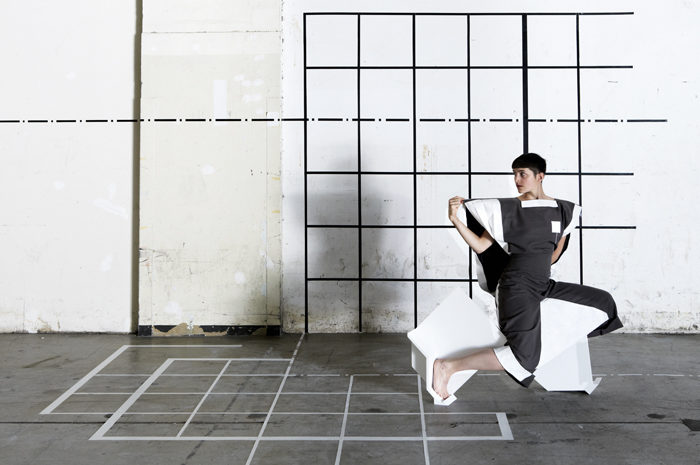WantedDesign is a dynamic connector and amplifier for global design, fostering creative synergy and serving as a pivotal crossroad for the international design community across Latin America, North America, and Europe.
Pathmakers at MAD Museum

Pathmakers at MAD Museum
Now on view at the Museum of Arts and Design, New York, until September 30th, 2015.
Pathmakers: Women in Art, Craft and Design, Midcentury and Today considers the important contributions of women to modernism in postwar visual culture. In the 1950s and 60s, an era when painting, sculpture, and architecture were dominated by men, women had considerable impact in alternative materials such as textiles, ceramics, and metals. Largely unexamined in major art historical surveys, either due to their gender or choice of materials, these pioneering women achieved success and international recognition, establishing a model of professional identity for future generations of women.
(Photo above: Gabriel A. Maher, DE___SIGN (video), 2014, courtesy of the artist)

We had the chance to spend time with Jennifer Scanlan, co-curator for the exhibit “Pathmakers: Women in Art, Craft, and Design, Midcentury and Today”, and ask her few questions.
WD: Why and how did you decide to focus on Women?
J.S.: The initial idea to focus on women came from my co-curator, Ezra Shales. He was doing research on women ceramists and noticed that the midcentury period had offered opportunities to women as teachers and designers that were unparalleled before, and to a certain extent, since. This led us to look at what women were accomplishing in fields and materials that have largely been left out, or have been included only on the periphery of traditional examinations of the history of design, including ceramics, textiles, and fine metalwork. More

WD: Why is the topic particularly relevant to bring to the public today?J.S.: Honestly, I think this topic should have been studied all along! Fortunately we are seeing a growing interest in expanding the narratives of design history to be more inclusive. It is a great opportunity to re-think accepted wisdom and enrich the design landscape with more voices.
WD: Do you think now is a special time/period for women in creative fields? specially in the US?
J.S.: I think women have always done amazing things in creative fields. Now they may be more visible for a number of reasons: it is much more common to see a woman at the head of a firm, making decisions and being given credit than it was during the midcentury period. The internet has allowed for new channels of information distribution, giving more direct access to people that might have been marginalized by traditional channels. And as I mentioned before, I think there is a conscious effort to support a greater diversity of voices in the creative fields, so there are publications, exhibitions, and organizations that showcase women, along with other groups that have been left out of the conversation.

WD: What are the main differences in between women and men creative processes and thinking? different approaches? different goals and focuses when it comes to design and make things?
J.S.: I’m not sure there are differences between men and women in terms of creativity—I think there are more differences between individual artists and designers, and it’s almost impossible to generalize by gender. Obviously there are social conditions that have influenced women’s access to creative making, and perhaps have also shaped their expression.
I know many people who disagree with me, however, so it is always an interesting discussion. One of the designers in the Pathmakers exhibition identifies as transgender, or gender queer, and feels that gender is fluid—the ideas of “male” and “female” are socially constructed. I wonder if in ten years we will have a completely different approach to the idea of dividing the world into “men” and “women.”
WD: Are there media that have been and are still more explored by women, and how do you explain it?
J.S.: I notice far more women in graphic design and textile design than in industrial design. I was hoping to answer this question through the exhibition, but I don’t think I was able to. Are these fields that are more accepting of women? Is this shift influenced by schools and teachers, by social expectations? Or perhaps it does have something to do with differences in creative process between men and women, and I am entirely wrong in my answer to your last question!

WD: We had the talk at WantedDesign on “Women, Creativity and Intuition”, do you feel intuition is very specific to women?
J.S.: As I mentioned above, I personally do not feel that intuition is necessarily specific to women, though we did have a very interesting discussion about that idea. Philip Fimmano of Li Edelkoort, for example, talked about “masculine” and “feminine” characteristics which might be attributed to designers of either gender. He considered intuition to be a feminine characteristic, which might be very present in a male designer. Patrizia Moroso, Creative Director of Moroso and Chantal Hamaide, publisher and editor of Intramuros magazine, talked about specific designers they knew, and felt that there were ways in which women’s creativity was different from men’s—for example, an interest in detail and tactility that seemed to be particularly female. It was hard to make generalizations, but interesting to think about specific designers within this context.
WD: Is there a common characteristic, beside gender, that somehow link all the artists/designers featured in Pathmakers?
J.S.: For this exhibition, we used the historic section to explore the ways in which women contributed to Modernism, as both an aesthetic and an approach, and for the contemporary section we were interested in artists and designers who explored the impact of the ”Pathmakers” in the historic section. Through this curatorial premise, the women were necessarily linked by a number of factors. Over the course of the research for this exhibition, however, we became even more aware of the number of women that we could have included and the variety of ways in which they influenced and continue to influence creative culture. Hopefully the legacy of this exhibition is that people do not focus on the ways in which women designers are similar, but realize that women contribute to the design world in many different ways, and in so doing render it rich, complex, and fascinating.


